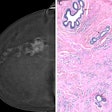Sentinel lymph node biopsy offers women a less-invasive alternative for diagnosis of small, infiltrating breast carcinoma. A meta-analysis of several sentinel node biopsy studies puts the accuracy rate for detecting the status of the axilla at 98%, according to a doctor from Memorial Sloan-Kettering Cancer Center in New York City.
Dr. Laura Liberman discussed the results of her analysis with attendees of the National Conference on Breast Cancer in San Francisco earlier this month. Liberman and her group analyzed 18 peer-reviewed published studies that correlated the results of sentinel node biopsy with axillary dissection. More than 2000 sentinel node biopsies were performed in the 18 studies, and the results were more than promising, Liberman said.
"Sentinel node biopsy is based on the sentinel lymph node hypothesis: The sentinel nodes are the first to drain a tumor. The status of the sentinel nodes should predict the status of the regional nodes," Liberman said. "Wouldn't it be nice if we had a relatively less-invasive way for identifying women with small invasive breast cancers?"
Liberman focused on two areas in the 18 studies: the physician's technique and the results of the biopsy. She also shared her institution's experience with sentinel node biopsy.
"The technical success of sentinel node biopsy is defined as the frequency with which sentinel nodes are found in surgery. We're not talking about how good they are at predicting the status of breast cancer. We're simply asking, 'If we've done the procedure, can we find the sentinel node?'" she explained.
In terms of technique, the studies in which two labeling agents were used in combination -- a radioisotope and blue dye -- had the highest success rate, 90%-100%, in pinpointing the sentinel node. The radioisotope allows the surgeon to localize the site of the sentinel node prior to making the incision, while the blue dye aids in visual identification.
Liberman also reported that the particle size of the radioisotope, in this case Tc-99m sulfur colloid, must meet two requirements.
"The particles have to be small enough so that they can travel, but big enough to get trapped in the first sentinel node," she said.
Unfiltered Tc-99m sulfur colloid fared better than a filtered version of the radioisotope because it was able to identify the sentinel lymph node in 88% of the cases, compared to the filtered variation, which found the node 66% of the time, Liberman said.
The volume and site of the injection also affected technical success. One group found that an intraparenchymal injection volume of 8cc or greater resulted in an increased tracer uptake into the lymphatics. The injection of intradermal blue dye and intramammary radioisotope resulted in the clearest delineation of the sentinel node.
As expected, the learning curve improved as clinicians became more adept at sentinel node biopsy. Technical success rates started out between 48% and 66% in 1994 trials. Three years later, the success rate ranged from 80% to 94%.
As with any new technology, there were a number of factors that adversely affected the success rate. Prior sentinel node biopsy can hinder the lymphatic drainage pathway's ability to uptake the radioisotope. Other factors associated with technical failure of sentinel node biopsy included patients over age 50 and medial tumor location, Liberman said.
With regard to the findings associated with sentinel node biopsy, the procedure worked best in the smallest tumors. Several studies reported an accuracy rate of 100% for tumors that measured less than 1.2 cm. However, the false-negative rate, or proportion of women with axillary metastases in whom sentinel nodes are reportedly free of tumor, averaged about 6%.
"That means 6% of the women who truly have metastases had a false-negative sentinel node. Is that good enough?" Liberman asked. She recommended including patients with confirmed axillary metastases in studies to determine a biopsy program's false-negative rate.
At Memorial Sloan-Kettering, sentinel node biopsy is offered as an alternative to axillary dissection for patients with T1 tumors and negative sentinel nodes. In a 1996 pilot study of 60 patients, the accuracy of the sentinel node in predicting axillary node status for T1 cancers was 98%. In a larger study of 500 patients, the procedure was successful in 92% of the cases.
"It's very important if you are undertaking to establish a sentinel lymph node biopsy program in your own institution that you look at the methodology and the success rates (of these studies) because you want to emulate those with the greatest success," Liberman concluded.
In a separate presentation, Dr. Steve Parker of the Sally Jobe Breast Centre in Denver discussed how an ultrasound-guided Mammotome could be used to image the sentinel nodes and possibly avoid more than one surgical procedure.
"What good does it do to have a mini excision lumpectomy if you are then going to do a full axillary node dissection? It defeats the purpose," Parker said.
Parker and his team worked with 20 patients who had injections of Tc-99m sulfur colloid adjacent to their primary breast cancer. The injection was followed by lymphoscintigraphy. The skin overlying the area was examined using a hand-held gamma dectector and with real-time sonography. A localizing wire was placed in the sentinel node and the area was surgically removed. In 95% of the cases, at least one sentinel node was successfully identified.
By Shalmali Pal
AuntMinnie.com staff writer
April 28, 2000
Let AuntMinnie.com know what you think about this story.
Copyright © 2000 AuntMinnie.com


















